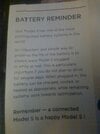Our Feb 2013 Model S 85 delivery is approaching its 10th Anniversary, and I thought I would post observations and battery degradation.
History: We took delivery of our early production (40xx VIN) in early February 2013. The battery pack was replaced under warranty during the first year, and has had no issues since then.
Charging: I charge almost every day, with the following settings: 90%, charging at 25 Amps after arriving home from work every day. It is only charged to 100% for trips, which is maybe 3 times a year.
I keep documented logs on all my cars. My present mileage is 102,003 miles.
Here are the numbers as of today: Max charge range when new: 264 miles. Current max charge range is 248-250 miles. This equals a battery degradation of 6% over 9 years.
Charging at 80 – 90% at a lower charge rate was recommended by the Tesla service center when we purchased the car. I do not know if is of any consequence, but our Model S is equipped with the optional dual chargers which was available as an option for the 2013 models.
Still loving the car and drive it every day as my daily driver. Just this morning coming into work I turned off the radio and enjoyed the silence (except for tire noise).

"Tesla Model S at a Supercharger" by Open Grid Scheduler / Grid Engine is marked with CC0 1.0.
(Image added by admin for purpose of TMC Blog)
History: We took delivery of our early production (40xx VIN) in early February 2013. The battery pack was replaced under warranty during the first year, and has had no issues since then.
Charging: I charge almost every day, with the following settings: 90%, charging at 25 Amps after arriving home from work every day. It is only charged to 100% for trips, which is maybe 3 times a year.
I keep documented logs on all my cars. My present mileage is 102,003 miles.
Here are the numbers as of today: Max charge range when new: 264 miles. Current max charge range is 248-250 miles. This equals a battery degradation of 6% over 9 years.
Charging at 80 – 90% at a lower charge rate was recommended by the Tesla service center when we purchased the car. I do not know if is of any consequence, but our Model S is equipped with the optional dual chargers which was available as an option for the 2013 models.
Still loving the car and drive it every day as my daily driver. Just this morning coming into work I turned off the radio and enjoyed the silence (except for tire noise).
"Tesla Model S at a Supercharger" by Open Grid Scheduler / Grid Engine is marked with CC0 1.0.
(Image added by admin for purpose of TMC Blog)



